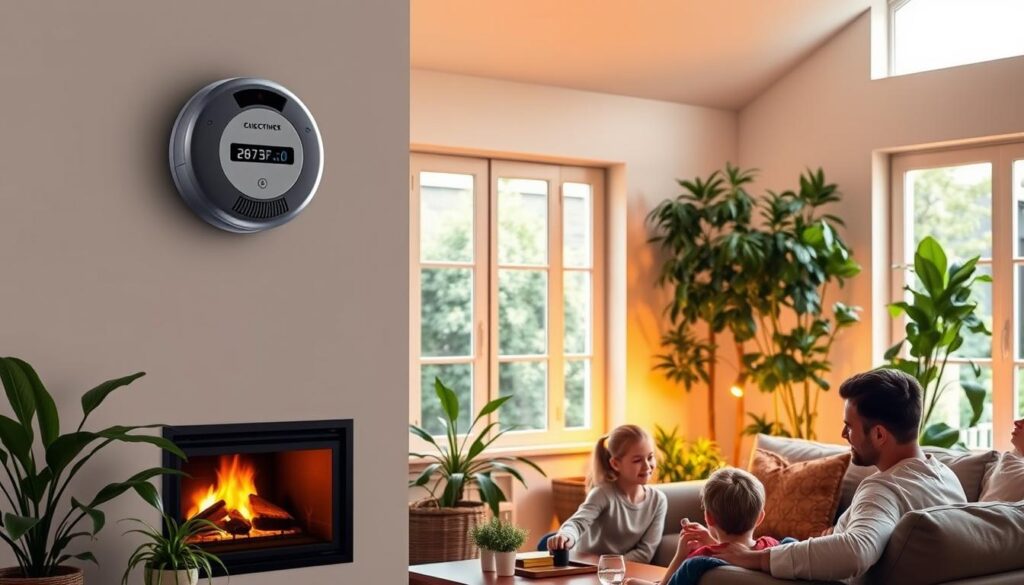Carbon monoxide is a silent killer that threatens homes across the U.S. This toxic gas strikes without warning, making it vital to prevent exposure1. Every year, thousands of families face its dangerous effects2.
Your indoor air quality hinges on knowing carbon monoxide risks. About 50,000 people visit ERs yearly due to CO poisoning2. Sadly, over 400 deaths occur annually from this invisible threat2.
These deaths can be prevented with proper safety measures1. Understanding the dangers is key to protecting your family and home.
Carbon monoxide is a colorless, odorless gas from burning fuels in home appliances3. Wood, oil, natural gas, kerosene, coal, and gasoline can create dangerous CO levels in enclosed spaces1.
Key Takeaways
- Carbon monoxide is a silent, potentially fatal toxic gas
- Install CO alarms on every home floor
- Check CO detector batteries every six months
- Never use fuel-burning devices in enclosed spaces
- Schedule annual maintenance for heating systems
- Ensure proper ventilation around fuel-burning appliances
Understanding the Silent Threat of Carbon Monoxide
Carbon monoxide is a deadly invisible danger in many homes. This odorless, colorless gas can quietly threaten your family’s safety. Knowing its risks and symptoms could save lives.
What Makes Carbon Monoxide So Dangerous
Carbon monoxide replaces oxygen in your blood when inhaled. It’s the leading cause of poisoning deaths. The gas comes from incomplete burning of fossil fuels in household items.
- Gas stoves
- Water heaters
- Furnaces
- Charcoal grills
- Fireplaces
- Motor vehicles
Recognizing Early Warning Signs and Symptoms
Spotting carbon monoxide symptoms early can prevent tragedy. The warning signs often look like flu symptoms, making them hard to spot4. Common symptoms include:
- Headaches
- Dizziness
- Nausea
- Weakness
- Shortness of breath
- Confusion
Certain groups face higher risks, like elderly people, babies, pregnant women, and those with heart or breathing problems5. High exposure to carbon monoxide can cause brain damage or death5.
Vigilance and early detection through carbon monoxide detectors are your best defense against this silent killer.
Carbon Monoxide Poisoning: Prevention and Detection Strategies
Protecting your home from carbon monoxide (CO) is vital. Over 430 people die yearly from CO poisoning. Only 27% of American homes have CO alarms, leaving many at risk6.
Effective prevention starts with smart alarm placement. The Consumer Product Safety Commission suggests specific locations for CO alarms.
- Near every sleeping area
- On each home level
- Within 10 feet of bedroom doors
- Away from humid areas and heating appliances
Good ventilation prevents dangerous CO buildup. Carbon monoxide often comes from gas ranges, generators, and heating systems. Regular upkeep can greatly lower risks.
“Prevention is always better than treatment when it comes to carbon monoxide exposure.” – Safety Experts
CO poisoning treatment can be tricky. Up to 40% of severe cases lead to long-term health issues6. Protect yourself with these steps:
- Testing alarms monthly
- Replacing detectors every 5-10 years
- Keeping fuel-burning appliances well-maintained
- Never using generators indoors
Stay alert and make your family’s safety a top priority against this hidden danger.
Conclusion
Carbon monoxide poisoning is a serious threat that requires your attention. It causes over 40,000 emergency visits yearly7. Protecting your indoor air quality is crucial for your safety. Understanding carbon monoxide risks is key to creating a safer home.
Your home’s safety relies on regular monitoring and upkeep. Install carbon monoxide detectors on every floor of your house. Test them every three months and change batteries yearly. Be extra careful during winter when poisoning incidents increase7.
Carbon monoxide exposure claims over 400 lives annually8. Prevention is vital for your family’s health and safety. Regular professional inspections of heating systems can reduce risks significantly.
Ensure proper ventilation and avoid using fuel-burning equipment indoors. If you feel dizzy, confused, or have a headache, leave immediately. Seek medical help right away. Your quick action could save lives.
By following these steps, you’re taking charge of your home’s safety. Carbon monoxide may be silent, but you can defend against it. With knowledge and preparation, you’ll keep your loved ones safe.
FAQ
What is carbon monoxide and why is it dangerous?
What are the early symptoms of carbon monoxide poisoning?
How can I prevent carbon monoxide poisoning in my home?
Where should I place carbon monoxide detectors?
What should I do if I suspect carbon monoxide poisoning?
Are certain people more at risk of carbon monoxide poisoning?
How often should I maintain my fuel-burning appliances?
Source Links
- Take Steps to Prevent Carbon Monoxide Poisoning – https://www.health.ny.gov/environmental/emergency/weather/carbon_monoxide/
- Carbon Monoxide Poisoning: How to Protect Your Family – https://www.healthychildren.org/English/safety-prevention/all-around/Pages/How-to-Prevent-Carbon-Monoxide-Poisoning.aspx
- How to avoid carbon monoxide poisoning at home – https://www.tdi.texas.gov/tips/how-to-avoid-carbon-monoxide-poisoning-at-home.html
- Microsoft Word – Carbon Monoxide safety.doc – https://www.darienct.gov/DocumentCenter/View/284/Carbon-Monoxide-Safety-PDF
- Carbon Monoxide: The Silent Killer – https://www.health.ny.gov/publications/2826.pdf
- Carbon Monoxide (CO) Poisoning Prevention – https://www.iafc.org/topics-and-tools/resources/resource/carbon-monoxide-(co)-poisoning-prevention
- Carbon monoxide poisoning (acute) – PMC – https://pmc.ncbi.nlm.nih.gov/articles/PMC2907971/
- Carbon Monoxide & Health | California Air Resources Board – https://ww2.arb.ca.gov/resources/carbon-monoxide-and-health
